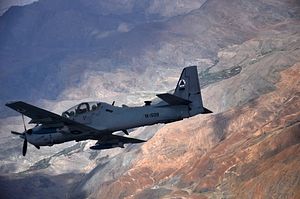While the Taliban officially launched their annual spring offensive this week pledging large-scale attacks, the Afghan National Defense and Security Forces (ANDSF) will for the first time in 15 years be able to deploy a light attack aircraft specifically designed for counterinsurgency operations in their fight against the insurgents.
The Afghan Air Force (AAF) will begin this year’s fighting season with eight new Embraer/Sierra Nevada Corporation A-29 Super Tucano light attack aircraft in its arsenal. The first four A-29 aircraft arrived at Hamid Karzai International Airport in Kabul on January 15. Four more planes were delivered in March.
No additional aircraft deliveries are expected this year. Four more A-29 Tucanos are slated for delivery in 2017 and the remaining eight will be handed over to the AAF by the end of 2018, bringing up the total number of A-29 Tucanos to 20. The United States Air Force funded the aircraft with $427 million under its so-called Light Air Support program.
As I reported previously (See: “Confirmed: First Four A-29 Light Attack Aircraft Arrive in Afghanistan”):
Brazilian aircraft maker Embraer and its U.S. partner Sierra Nevada Corporation where initially awarded the contract to supply 20 A-29 light attack aircraft in 2011. However, the contract was cancelled in 2012 due to a dissatisfaction of USAF leadership “with the quality of the documentation supporting the award decision.” However, the contract was re-awarded to Embraer and Sierra Nevada Corporation in 2013.
“In hindsight, I wish we would’ve started that years ago,” the commander of U.S. Forces in Afghanistan, General John F. Campbell said in front of the U.S. House of Representatives Armed Services Committee in March 2015, yet “we are where we are. (…) Quite frankly, we can’t get it out there quick enough for them.”
The new light attack aircraft will likely be deployed to the eastern province of Nangarhar and the southern province of Helmand, where government forces have been engaged in heavy fighting with insurgents for the past couple of months. The A-29 turboprop planes will first and foremost be used in close-air-support (CAS) missions with airstrikes called in by so-called tactical air controllers. “The ATACs [Afghan Tactical Air Controllers] coordinate requests for air casualty evacuation, close air support, aerial resupply and airlift. They also deconflict air-to-ground fires from ground-to-ground fires for ANA [Afghan National Army] operations,” according to a U.S. Air Force report.
The A-29 can be armed with two 500-pound (226 kilogram) bombs (including precision-guided munitions), twin .50-caliber machine guns and rockets. In detail, the plane features “five hardpoints under the wing and a fuselage that can carry up to 1,500 kg of additional weapons. These can include .50 cal or 20 mm gun pods, rocket pods, short-range air-air missiles of the AIM-9X class, and conventional or smart freefall bombs,” according to IHS Jane’s Defense Weekly.
Will the new light attack aircraft make a difference on the battlefield?
Next to providing a much needed boost in the ANDSF’s fighting morale, the A-29 will increase the number of CAS missions the AAF can fly in support of ground operations. The A-29 will also be a more capable aircraft than the MD530F Cayuse Warrior light attack helicopters and Mi-24/35 attack helicopter gunships currently used in CAS missions by the ANDSF.
The presence of the A-29 will also force the different sub-branches of the ANDSF to more closely coordinate their missions with each other, given the complexity of coordinating air strikes and artillery fire with ground movements involving the ANA, Afghan National Police, and other government forces.
Due to the inexperience of the AAF coordinating air strikes with the ANA, we can expect that the aircraft may be less effective in supporting ANDSF operations initially and the potential for friendly-fire incidents will be high throughout the 2016 fighting season, in particular during large-scale and complex clearing operations.
What will determine the impact of the new aircraft more than anything else, however, is how the A-29 will be used during the 2016 fighting season by senior Afghan military leadership, since this will have an direct impact on the military culture of the ANA for the years to come.
For one thing, the Afghan senior military leadership will have to see that the A-29 aircraft will not be deployed in a similar fashion to the Afghan Special Operations Forces (SOF), i.e. serving as a mobile rapid reaction force for regular ANA units who deem themselves incapable of going on the offensive without the presence of SOF.
Should an Afghan corps commander, for example, decide that the presence of A-29 planes will be a precondition for going on the offensive, the aircraft might even have a detrimental effect on military operations by slowing down the operational pace of the ANDSF on the battlefield, given both the limited number of A-29 aircraft available (as well as the much reduced NATO coalition CAS capability).
Overall, the induction of the A-29 light attack aircraft will bring the ANDSF a step closer to becoming a more professional fighting force. However, we should not expect that the new planes will be able to reverse overall battlefield failures and the aircraft will certainly not be capable of guaranteeing battlefield successes on its own.































